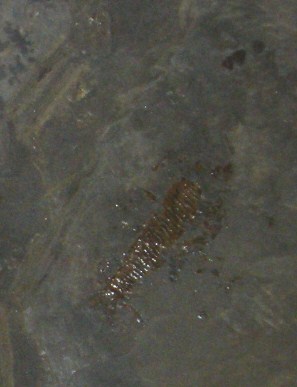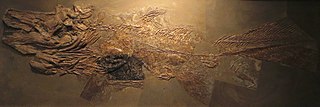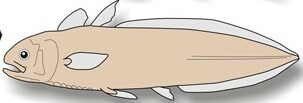
Rhabdoderma is an extinct genus of coelacanth fish in the class Sarcopterygii. It lived in the Carboniferous and Early Triassic (Induan), and its fossils have been found in Europe, Madagascar and North America. The type species was originally described as Coelacanthus elegans. Five species are considered valid in 1981.
Axelia is an extinct genus of prehistoric lobe-finned fish, which belonged to the family of Coelacanthidae. It lived during the Smithian age of the Early Triassic epoch in what is now Spitsbergen, Svalbard. Fossils were found in the "Fish Niveau" of the Lusitaniadalen Member of the Vikinghøgda Formation.

Whiteia is an extinct genus of prehistoric coelacanth fish which lived during the Triassic period. It is named after Errol White.

Sinocoelacanthus is an extinct genus of prehistoric coelacanth that lived during the Early Triassic epoch.
Dorsolepis is an extinct genus of prehistoric bony fish that lived during the early Anisian age in what is now France (Alsace) and Germany (Baden-Württemberg). Fossils were found in the Grès à Voltzia in Alsace and in the Buntsandstein in Baden-Württemberg.

Garnbergia is an extinct genus of prehistoric coelacanth that lived during the Anisian stage of the Middle Triassic epoch. It was discovered by Martin and Wenz in 1984. It comprises a single species, Garnbergia ommata.

Habroichthys is an extinct genus of prehistoric bony fish that lived during the early Ladinian stage of the Middle Triassic epoch, 242 to 232 million years ago. It has been found in Austria, China, Italy, Slovenia, and Switzerland. It was a small fish measuring 26 cm (10 in) long.

Heptanema is an extinct genus of prehistoric coelacanth from the Middle Triassic (Ladinian) of northern Italy and southern Switzerland.

Mylacanthus is an extinct genus of prehistoric coelacanth lobe-finned fish that lived during the Smithian age of the Early Triassic epoch in what is now Svalbard.
Moenkopia is an extinct genus of prehistoric sarcopterygians from the Coelacanthidae found in the Middle Triassic Moenkopi Formation of Arizona. The type, and only species, M. wellesi, was named in 1961 in honour of Samuel Paul Welles. It is only known from the holotype, UMCP 36193, a partial skull consisting only of the basisphenoid that was collected in 1939 or 1940 by Samuel Welles and briefly noted on by him in 1947, and other assorted specimens found before 2005 in the Radar Mesa by S. J. Nesbitt, W. G. Parker and R. B. Irmis.
Sassenia is an extinct genus of prehistoric coelacanth lobe-finned fish that lived during the Early Triassic epoch in what is now East Greenland and Svalbard.

Trachymetopon is an extinct genus of prehistoric coelacanth from the Jurassic of Europe. Fossils have been found in the Early Jurassic Posidonia Shale of Germany the Middle Jurassic Marnes de Dives of France, and probably the Late Jurassic Kimmeridge Clay of England. Only one species has been named, Trachymetopon liassicum, described by Henning in 1951 from an almost complete specimen found in the Lower Toarcian of Ohmden in Baden-Württemberg. Another specimen is known from the same site, and two older specimens come from the Sinemurian of Holzmaden. The holotype of this species is 1.6 metres in length. A giant specimen of an undetermined species of Trachymetopon found at the Middle Jurassic Falaises des Vaches Noires of Normandy. This specimen, composed of a 53 cm long palatoquadrate, belongs to an individual 4 metres (13 ft) in length. A basisphenoid found in a museum in Switzerland that likely originates from the same locaity probably belonged to an individual around 5 m (16 ft) long, making Trachymetopon the largest of all coelacanths alongside Mawsonia. A study published in 2015 revealed that this coelacanth belongs to the Mawsoniidae. Trachymetopon is one of the few known mawsoniids to have been exclusively marine, while most of the other members of the group have lived in fresh and brackish waters.
Spermatodus is an extinct genus of coelacanths, which lived during the Artinskian age of the Cisuralian epoch in what is now Oklahoma and Texas, United States.
Uydenia is an extinct genus of prehistoric bony fish from the Cisuralian of Kazakhstan.

Gyrolepis is an extinct genus of prehistoric ray-finned fish from the Middle-Late Triassic epochs in what is now Europe. It is known both from complete specimens and isolated skeletal elements, such as scales or teeth.

Holopterygius is an extinct genus of prehistoric eel-like coelacanth known from the Devonian (Givetian–Frasnian) of Germany. Despite its specialized morphology and superficial dissimilarity to the usual Paleozoic coelacanth body plan, it is one of the most basal actinistian fish.
Platysiagum is an extinct genus of prehistoric bony fish belonging to the family Platysiagidae. Fossils are known from the Middle Triassic of China, Italy and Switzerland, and the Early Jurassic of England.

Ardoreosomus is an extinct genus of marine ray-finned fish. It was described from the Induan aged Candelaria Formation of Nevada, United States, which was located near the equator during the Early Triassic epoch. It contains only one species, A. occidentalis (monotypy).
Turseodus is an extinct genus of ray-finned fish found in Late Triassic freshwater sediments of the United States. Two species have been described, T. acutus from the Lockatong Formation of Pennsylvania, and T. dolorensis from the Chinle Formation of Colorado.

Rieppelia is an extinct genus of latimeriid coelacanth fish from the Middle Triassic of Switzerland, in what is now Monte San Giorgio. It contains a single species, R. heinzfurreri.















